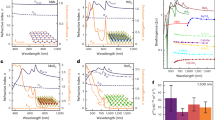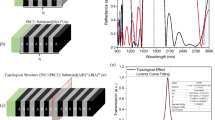Abstract
Central to the field of nanophotonics is the ability to engineer the flow of light through nanoscale structures. These structures often have permanent working spectral ranges and optical properties that are fixed during fabrication. Quantum materials, with their correlated and intertwined degrees of freedom, offer a promising avenue for dynamically controlling photonic devices without altering their physical structure. Here we fabricate photonic crystal slabs from CrSBr, a van der Waals antiferromagnetic semiconductor, and demonstrate in situ control over their optical properties. Leveraging the combination of the exceptionally large refractive index of CrSBr near its excitonic resonances and its tunability via external fields, we achieve precise manipulation of photonic modes at near-visible and infrared wavelengths, showcasing a new paradigm for nanophotonic device design. The resulting guided resonances of the photonic crystal are tightly packed in the spectrum with very small mode volumes, are highly tunable via external magnetic fields and exhibit high Q factors exceeding 1,200. These resonances self-hybridize with the excitonic degrees of freedom, resulting in intrinsic strong light–matter coupling. Our findings underscore the potential of quantum materials for developing in situ tunable photonic elements and cavities.
This is a preview of subscription content, access via your institution
Access options
Access Nature and 54 other Nature Portfolio journals
Get Nature+, our best-value online-access subscription
$32.99 / 30 days
cancel any time
Subscribe to this journal
Receive 12 print issues and online access
$259.00 per year
only $21.58 per issue
Buy this article
- Purchase on SpringerLink
- Instant access to full article PDF
Prices may be subject to local taxes which are calculated during checkout




Similar content being viewed by others
Data availability
Raw experimental data used in the article are available via Harvard Dataverse at https://doi.org/10.7910/DVN/1NPBTC.
References
Zhang, X. et al. Guiding of visible photons at the ångström thickness limit. Nat. Nanotechnol. 14, 844–850 (2019).
Sung, J. et al. Room-temperature continuous-wave indirect-bandgap transition lasing in an ultra-thin WS2 disk. Nat. Photonics 16, 792–797 (2022).
Wu, S. et al. Monolayer semiconductor nanocavity lasers with ultralow thresholds. Nature 520, 69–72 (2015).
Ye, Y. et al. Monolayer excitonic laser. Nat. Photonics 9, 733–737 (2015).
Munkhbat, B. et al. Transition metal dichalcogenide metamaterials with atomic precision. Nat. Commun. 11, 4604 (2020).
Lin, H. et al. Diffraction-limited imaging with monolayer 2D material-based ultrathin flat lenses. Light Sci. Appl. 9, 137 (2020).
Scuri, G. et al. Large excitonic reflectivity of monolayer MoSe2 encapsulated in hexagonal boron nitride. Phys. Rev. Lett. 120, 037402 (2018).
Back, P., Zeytinoglu, S., Ijaz, A., Kroner, M. & Imamoğlu, A. Realization of an electrically tunable narrow-bandwidth atomically thin mirror using monolayer MoSe2. Phys. Rev. Lett. 120, 037401 (2018).
Kim, S. et al. Photonic crystal cavities from hexagonal boron nitride. Nat. Commun. 9, 2623 (2018).
Caldwell, J. D. et al. Photonics with hexagonal boron nitride. Nat. Rev. Mater. 4, 552–567 (2019).
Klembt, S. et al. Exciton–polariton topological insulator. Nature 562, 552–556 (2018).
Zhang, L., Gogna, R., Burg, W., Tutuc, E. & Deng, H. Photonic-crystal exciton–polaritons in monolayer semiconductors. Nat. Commun. 9, 713 (2018).
Laitz, M. et al. Uncovering temperature-dependent exciton–polariton relaxation mechanisms in hybrid organic-inorganic perovskites. Nat. Commun. 14, 2426 (2023).
Byrnes, T., Kim, N. Y. & Yamamoto, Y. Exciton–polariton condensates. Nat. Phys. 10, 803–813 (2014).
Deng, H., Weihs, G., Santori, C., Bloch, J. & Yamamoto, Y. Condensation of semiconductor microcavity exciton polaritons. Science 298, 199–202 (2002).
Gibbs, H. M., Khitrova, G. & Koch, S. W. Exciton–polariton light–semiconductor coupling effects. Nat. Photonics 5, 273–273 (2011).
Liu, X. et al. Strong light–matter coupling in two-dimensional atomic crystals. Nat. Photonics 9, 30–34 (2015).
Dirnberger, F. et al. Spin-correlated exciton–polaritons in a van der Waals magnet. Nat. Nanotechnol. 17, 1060–1064 (2022).
Li, Q. et al. Two-dimensional magnetic exciton polariton with strongly coupled atomic and photonic anisotropies. Phys. Rev. Lett. 133, 266901 (2024).
Maggiolini, E. et al. Strongly enhanced light–matter coupling of monolayer WS2 from a bound state in the continuum. Nat. Mater. 22, 964–969 (2023).
Weber, T. et al. Intrinsic strong light–matter coupling with self-hybridized bound states in the continuum in van der Waals metasurfaces. Nat. Mater. 22, 970–976 (2023).
Dirnberger, F. et al. Magneto-optics in a van der Waals magnet tuned by self-hybridized polaritons. Nature 620, 533–537 (2023).
Jarc, G. et al. Cavity-mediated thermal control of metal-to-insulator transition in 1T-TaS2. Nature 622, 487–492 (2023).
Latini, S. et al. The ferroelectric photo ground state of SrTiO3: cavity materials engineering. Proc. Natl Acad. Sci. USA 118, e2105618118 (2021).
Viñas Boström, E., Sriram, A., Claassen, M. & Rubio, A. Controlling the magnetic state of the proximate quantum spin liquid α-RuCl3 with an optical cavity. npj Comput. Mater. 9, 202 (2023).
Basov, D. N., Averitt, R. D. & Hsieh, D. Towards properties on demand in quantum materials. Nat. Mater. 16, 1077–1088 (2017).
Wilson, N. P. et al. Interlayer electronic coupling on demand in a 2D magnetic semiconductor. Nat. Mater. 20, 1657–1662 (2021).
Jiang, S., Li, L., Wang, Z., Mak, K. F. & Shan, J. Controlling magnetism in 2D CrI3 by electrostatic doping. Nat. Nanotechnol. 13, 549–553 (2018).
Bagani, K. et al. Imaging strain-controlled magnetic reversal in thin CrSBr. Nano Lett. 24, 13068–13074 (2024).
Cenker, J. et al. Reversible strain-induced magnetic phase transition in a van der Waals magnet. Nat. Nanotechnol. 17, 256–261 (2022).
Pawbake, A. et al. Magneto-optical sensing of the pressure driven magnetic ground states in bulk CrSBr. Nano Lett. 23, 9587–9593 (2023).
Bae, Y. J. et al. Exciton-coupled coherent magnons in a 2D semiconductor. Nature 609, 282–286 (2022).
Cham, T. M. J. et al. Anisotropic gigahertz antiferromagnetic resonances of the easy-axis van der Waals antiferromagnet CrSBr. Nano Lett. 22, 6716–6723 (2022).
Lee, K. et al. Magnetic order and symmetry in the 2D semiconductor CrSBr. Nano Lett. 21, 3511–3517 (2021).
Ziebel, M. E. et al. CrSBr: an air-stable, two-dimensional magnetic semiconductor. Nano Lett. 24, 4319–4329 (2024).
Rizzo, D. J. et al. Visualizing atomically layered magnetism in CrSBr. Adv. Mater. 34, 2201000 (2022).
Klein, J. et al. The bulk van der Waals layered magnet CrSBr is a quasi-1D material. ACS Nano 17, 5316–5328 (2023).
Nessi, L., Occhialini, C. A., Demir, A. K., Powalla, L. & Comin, R. Magnetic field tunable polaritons in the ultrastrong coupling regime in CrSBr. ACS Nano 18, 34235–34243 (2024).
Datta, B., Adak, P.C., Yu, S. et al. Magnon-mediated exciton–exciton interaction in a van der Waals antiferromagnet. Nat. Mater. https://doi.org/10.1038/s41563-025-02183-0 (2025).
Shi, J. et al. Giant magneto-exciton coupling in 2D van der Waals CrSBr. Preprint at https://arxiv.org/abs/2409.18437v1 (2024).
Barcons Ruiz, D. et al. Engineering high quality graphene superlattices via ion milled ultra-thin etching masks. Nat. Commun. 13, 6926 (2022).
Demir, A. K. et al. Transferable optical enhancement nanostructures by gapless stencil lithography. Nano Lett. 24, 9882–9888 (2024).
Liu, V. & Fan, S. S4: a free electromagnetic solver for layered periodic structures. Comput. Phys. Commun. 183, 2233–2244 (2012).
Wang, T. et al. Magnetically-dressed CrSBr exciton–polaritons in ultrastrong coupling regime. Nat. Commun. 14, 5966 (2023).
Ruta, F. L. et al. Hyperbolic exciton polaritons in a van der Waals magnet. Nat. Commun. 14, 8261 (2023).
Suárez-Forero, D. G. et al. Chiral flat-band optical cavity with atomically thin mirrors. Sci. Adv. 10, eadr5904 (2024).
Kodigala, A. et al. Lasing action from photonic bound states in continuum. Nature 541, 196–199 (2017).
Hsu, C. W. et al. Observation of trapped light within the radiation continuum. Nature 499, 188–191 (2013).
Fan, S. & Joannopoulos, J. D. Analysis of guided resonances in photonic crystal slabs. Phys. Rev. B 65, 235112 (2002).
Cerjan, A. et al. Observation of bound states in the continuum embedded in symmetry bandgaps. Sci. Adv. 7, eabk1117 (2021).
Vaidya, S., Benalcazar, W. A., Cerjan, A. & Rechtsman, M. C. Point-defect-localized bound states in the continuum in photonic crystals and structured fibers. Phys. Rev. Lett. 127, 023605 (2021).
Zhang, T. et al. Magnetism and optical anisotropy in van der waals antiferromagnetic insulator CrOCl. ACS Nano 13, 11353–11362 (2019).
Gu, P. et al. Photoluminescent quantum interference in a van der Waals magnet preserved by symmetry breaking. ACS Nano 14, 1003–1010 (2020).
Guo, Q. et al. Ultrathin quantum light source with van der Waals NbOCl2 crystal. Nature 613, 53–59 (2023).
Guo, Q. et al. Colossal in-plane optical anisotropy in a two-dimensional van der Waals crystal. Nat. Photonics 18, 1170–1175 (2024).
Song, Q. et al. Evidence for a single-layer van der Waals multiferroic. Nature 602, 601–605 (2022).
Tabataba-Vakili, F. et al. Doping-control of excitons and magnetism in few-layer CrSBr. Nat. Commun. 15, 4735 (2024).
Ergoktas, M. S. et al. Localized thermal emission from topological interfaces. Science 384, 1122–1126 (2024).
He, L., Wu, J., Jin, J., Mele, E. J. & Zhen, B. Polaritonic Chern insulators in monolayer semiconductors. Phys. Rev. Lett. 130, 043801 (2023).
Uemura, T. et al. Photonic topological phase transition induced by material phase transition. Sci. Adv. 10, eadp7779 (2024).
Guddala, S. et al. Topological phonon–polariton funneling in midinfrared metasurfaces. Science 374, 225–227 (2021).
Li, M. et al. Experimental observation of topological Z2 exciton–polaritons in transition metal dichalcogenide monolayers. Nat. Commun. 12, 4425 (2021).
Liu, W. et al. Generation of helical topological exciton–polaritons. Science 370, 600–604 (2020).
Acknowledgements
We acknowledge helpful discussions with M. Butun. This material is based upon work supported by the US Department of Energy, Office of Science National Quantum Information Science Research Center’s Co-design Center for Quantum Advantage (C2QA) under contract number DE-SC0012704 (R.C.). C2QA led in this research. This material is also based upon work sponsored in part by the US Army DEVCOM ARL Army Research Office through the MIT Institute for Soldier Nanotechnologies under Cooperative Agreement number W911NF-23-2-0121 (M.S.). This work was performed in part on the Raith VELION FIB-SEM in the MIT.nano Characterization Facilities (award number DMR-2117609) and in Fab.nano and Characterization.nano facilities at MIT.nano. A.K.D. acknowledges support from MathWorks Science Fellowship.
Author information
Authors and Affiliations
Contributions
A.K.D., L.N. and R.C. conceived the project. A.K.D. performed the nanofabrication and carried out the experiments together with L.N., with help from C.A.O., under the supervision of R.C. S.V., supervised by M.S., and A.K.D. performed the simulations. All authors contributed to the writing of the paper.
Corresponding author
Ethics declarations
Competing interests
The authors declare no competing interests.
Peer review
Peer review information
Nature Photonics thanks Alexander Khanikaev, Angel Rubio and the other, anonymous, reviewer(s) for their contribution to the peer review of this work.
Additional information
Publisher’s note Springer Nature remains neutral with regard to jurisdictional claims in published maps and institutional affiliations.
Supplementary information
Supplementary Information
Supplementary Figs. 1–17, Notes 1 and 2 and Table 1.
Rights and permissions
About this article
Cite this article
Demir, A.K., Nessi, L., Vaidya, S. et al. Tunable nanophotonic devices and cavities based on a two-dimensional magnet. Nat. Photon. 19, 1006–1012 (2025). https://doi.org/10.1038/s41566-025-01712-2
Received:
Accepted:
Published:
Issue date:
DOI: https://doi.org/10.1038/s41566-025-01712-2



